Core Technology Overview
G-Rex’s (gas permeable, rapid expansion) core technology can be understood in three simple concepts:
- A gas-permeable, liquid impermeable silicone membrane upon which cells reside in suspension and through which cells obtain oxygen.
- A naturally occurring boundary layer within which cells reside and “talk” to each other via paracrine signaling
- A large column of media that is kept homogenous through natural convection from which cells draw nutrients and into which cells secrete (and dilute) their waste.
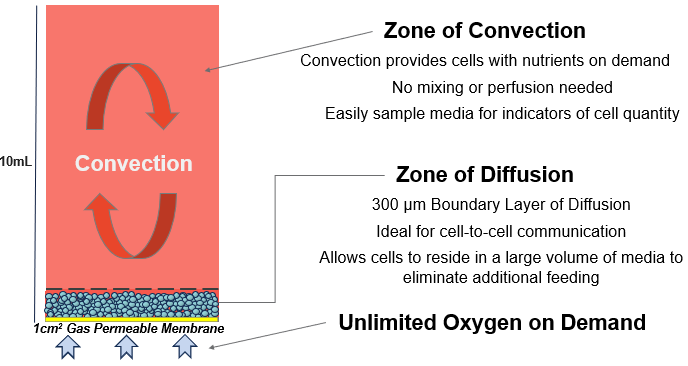
The combination of these basic elements confer the following benefits:
- Cells obtain nutrients and oxygen automatically without the need for mechanized equipment
- Cells can be grown to high density without needing media exchanges or perfusion
- Cells maintain high viability and favorable phenotypes desirable in adoptive cell therapy
G-Rex is the only technology that does not require mechanized nutrient or oxygen delivery and does not require custom pH and temperature control.
Moreover, the simplicity of the G-Rex confers the following advantages:
- G-Rex utilizes standard incubators and lab equipment common to all cell culture labs, reducing costs and increasing access to CGTs through equitable manufacturing
- G-Rex devices are linearly scalable because they are built with consistent geometry and materials but with varying membrane surface areas
- G-Rex is a platform whose expansive catalogue includes many devices, formats, grades, etc. that maximizes operational flexibility across the entire CGT organization
The result? A revolutionary technology used by over 1,000 organizations doing CGT research & discovery, preclinical and clinical development, and commercial production of five (5) approved drug products (including the world’s most financially successful and most commercially scalable CGT drug product).
Visit our Knowledge Center to browse hundreds of peer-reviewed manuscripts related to all forms of CGT modalities including CAR/TCR-T cells, Natural Killer (NK) cells, Tumor Infiltrating Lymphocytes (TIL), regulatory T cells (Treg), gamma delta T cells, virus- and tumor antigen-specific T cells, hematopoietic stem cells (HSC), and more!
G-Rex Membrane
The G-Rex membrane is made from a USP Class IV silicone elastomer which has been shown to be several orders of magnitude more permeable to O2 & CO2 than the material from which gas-permeable bags are made (FEP).
The G-Rex membrane is not plasma-charged or texturized and naturally supports suspension culture. It has been previously demonstrated that coating materials such as RetroNectin can be applied to the membrane to enhance unit operations such as T cell activation (via immobilization of activating antibodies) and T cell transduction.
Fekete, N., Béland, A. V., Campbell, K., Clark, S. L., & Hoesli, C. A. (2018). Bags versus flasks: A comparison of cell culture systems for the production of dendritic cell–based immunotherapies. Transfusion, 58(7), 1800–1813. https://doi.org/10.1111/trf.14621
Is the G-Rex membrane impermeable to adventitious agents (bacteria, virus, etc.)?
Yes, Wilson Wolf has validated through microbial ingress and viral penetration tests that the G-Rex membrane is impermeable to adventitious agents. The membrane’s impermeability to adventitious agents is core to the closed system G-Rex validation package. It is also what enables the G-Rex to integrate all core CAR/TCR T cell therapy unit operations: Separation, Activation, Transduction, Expansion, and Concentration.
Is the G-Rex membrane tested for "holes" or "leaks" prior to shipment to a customer?
Yes, all G-Rex devices are subjected to a highly sensitive pressure decay testing prior to sterilization and shipment. The pressure decay testing is a sophisticated method that ensures no defective G-Rex are shipped to customers.
Is the same G-Rex membrane used in all G-Rex devices?
Zone of Diffusion (Boundary Layer)
In physics and fluid mechanics, a boundary layer is the thin layer of fluid in the immediate vicinity of a bounding surface formed by the fluid flowing along the surface. The fluid’s interaction with the wall induces a no-slip boundary condition (zero velocity at the wall). The flow velocity then monotonicaly increases above the surface until it returns to the bulk flow velocity. The thin layer consisting of fluid whose velocity has not yet returned to the bulk flow velocity is called the velocity boundary layer.
Scanning electron microscopy images have demonstrated that the G-Rex’s boundary layer is approximately 300 microns in height above the silicone and this is the area where the cells grow within. Thus, the size of the cell being grown will determine how many cells can be grown on a per cm^2 basis.
| CELL TYPE | DIAMETER | MAX DENSITY |
|---|---|---|
T cells |
8-9um
|
30-40M cells/cm2
|
NK cells |
8-9um
|
30-40M cells/cm2
|
k562 |
17-22um
|
12-15M cells/cm2
|
Hybridoma |
11-13um
|
15-16M cells/cm2
|
Does the G-Rex maintain polyclonality of cells as they grow within the Boundary Layer?
Yes, it has been demonstrated that polyclonality is maintained and that cells expanding with the oxygen & nutrient rich boundary layer maintain clonal diversity.
This is of particular importance to developers of Tumor Infiltrating Lymphocyte (TIL) therapies where clonal diversity is an asset.
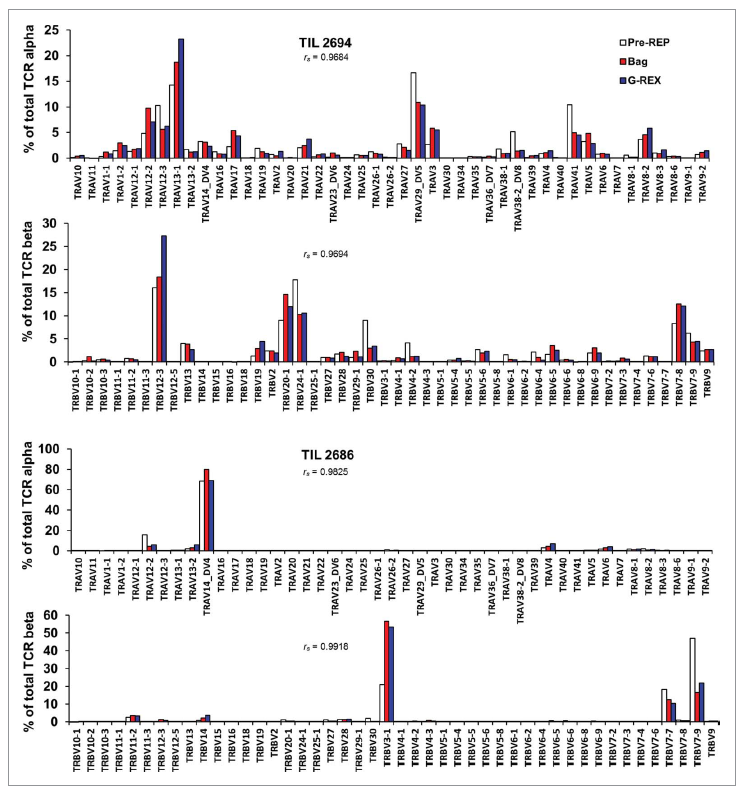
Forget, M.-A., Haymaker, C., Dennison, J. B., Toth, C., Maiti, S., Fulbright, O. J., Cooper, L. J., Hwu, P., Radvanyi, L. G., & Bernatchez, C. (2015). The beneficial effects of a gas-permeable flask for expansion of tumor-infiltrating lymphocytes as reflected in their mitochondrial function and respiration capacity. OncoImmunology, 5(2). https://doi.org/10.1080/2162402x.2015.1057386
What are the benefits of keeping the cells within the Boundary Layer?
A core benefit of static culture is that there is extensive cell-to-cell contact and any secreted factors essential to cell expansion will exist as gradients, with the highest concentration surrounding the cells.
Contrast this with perfusion systems, such as WAVE, where any secreted factors will be diluted by the continual perfusion while the constant motion will reduce the overall time the cells spend in contact with each other.
Somerville, R. P., Devillier, L., Parkhurst, M. R., Rosenberg, S. A., & Dudley, M. E. (2012). Clinical scale rapid expansion of lymphocytes for adoptive cell transfer therapy in the WAVE® bioreactor. Journal of Translational Medicine, 10(1). https://doi.org/10.1186/1479-5876-10-69
How can I leverage the Boundary Layer to my advantange?
The highly oxygenated, nutrient rich, and no-sheer boundary layer confers the following benefits:
- promotes higher viability rates and rescues “poor growing” cells (1) relative to T-flasks and gas-permeable bags
- Improved survival rates (2) lowers the number of population doublings to make dose and maintains a more stem-like, less exhausted phenotype.
- A metabolic profile less reliant on glycolysis (3)(4) makes more efficient use of media and cytokines
Because the Boundary Layer is a fixed 300um zone, it also results in predictable yields despite variable starting material quantity (and quality).
(1) Forget, M.-A., Haymaker, C., Dennison, J. B., Toth, C., Maiti, S., Fulbright, O. J., Cooper, L. J., Hwu, P., Radvanyi, L. G., & Bernatchez, C. (2015). The beneficial effects of a gas-permeable flask for expansion of tumor-infiltrating lymphocytes as reflected in their mitochondrial function and respiration capacity. OncoImmunology, 5(2). https://doi.org/10.1080/2162402x.2015.1057386
(2) Vera JF, Brenner LJ, Gerdemann U, Ngo MC, Sili U, Liu H, Wilson J, Dotti G, Heslop HE, Leen AM, Rooney CM. Accelerated production of antigen-specific T cells for preclinical and clinical applications using gas-permeable rapid expansion cultureware (G-Rex). J Immunother. 2010 Apr;33(3):305-15. doi: 10.1097/CJI.0b013e3181c0c3cb. PMID: 20445351; PMCID: PMC2946348.
(3) Hannah W. Song, Michaela Prochazkova, Lipei Shao,Roshini Traynor, Sarah Underwood, Mary Black, Vicki Fellowes, Rongye Shi, Marie Pouzolles, Hsien-Chao Chou, Adam T. Cheuk, Naomi Taylor, Ping Jin, Robert P. Somerville, David F. Stroncek, Javed Khan, Steven L. Highfill, CAR-T cell expansion platforms yield distinct T cell differentiation states, Cytotherapy (2024), doi; https://doi.org/10.1016/j.jcyt.2024.03.003
(4) Pisani, I., Melita, G., de Souza, P. B., Galimberti, S., Savino, A. M., Sarno, J., Landoni, B., Crippa, S., Gotti, E., Cuofano, C., Pedrini, O., Capelli, C., Matera, G., Belotti, D., Cesana, S., Cabiati, B., Quaroni, M., Colombo, V., Mazza, M., … Tettamanti, S. (2025a). Optimized GMP-grade production of non-viral sleeping beauty-generated carcik cells for enhanced fitness and clinical scalability. Journal of Translational Medicine, 23(1). https://doi.org/10.1186/s12967-025-06416-3
Zone of Natural Convection
The G-Rex is unique in its ability to support cell cultures with large media volumes in a static environment without resorting to mechanical agitation. This phenomenon is likely caused by a thermal differential between the heat source (the incubator) and the medium. Therefore, due to convection, warmer medium adjacent to the walls of the G-Rex will move toward the core, displacing colder media to the periphery. This cycle is perpetuated, resulting in a homogenous mixing of the medium without disturbing the cells growing on the silicone membrane.
The “golden ratio” of 10mL/cm2 was determined through media titration studies (Right) to be the least amount of media required to sustain a culture from a seeding density to maximum cell density without the need to exchange the culture media.
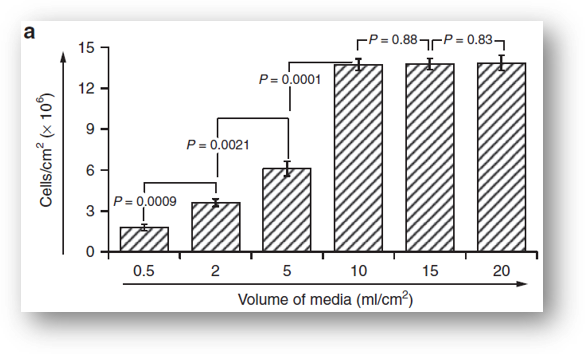
How do you know that the media is homogenous?
If the media column was stagnant, then metabolite gradients would form as the cells expand, which is not what is observed. For example, as T cells expand they secrete lactate and the lactate concentration can be measured at the top, bottom, middle, and periphery of the G-Rex. If there was no convection, a lactate gradient would form with higher concentration of lactate at the bottom nearest the cells. Again, this is not what is observed.
Do I still have to continuous supplemental with cytokines and other growth factors?
No, there are several reasons why G-Rex production does not require intermittent supplementation of cytokines:
- the boundary layer allows cells to sustain their own growth through extensive cell-to-cell contact and paracrine signaling
- cytokines are more stable at 37C than previously thought.
The figure on the right shows the results of a “Fill and Forget” approach where T cells are allowed to expand undisturbed in the incubator for over 5 days.
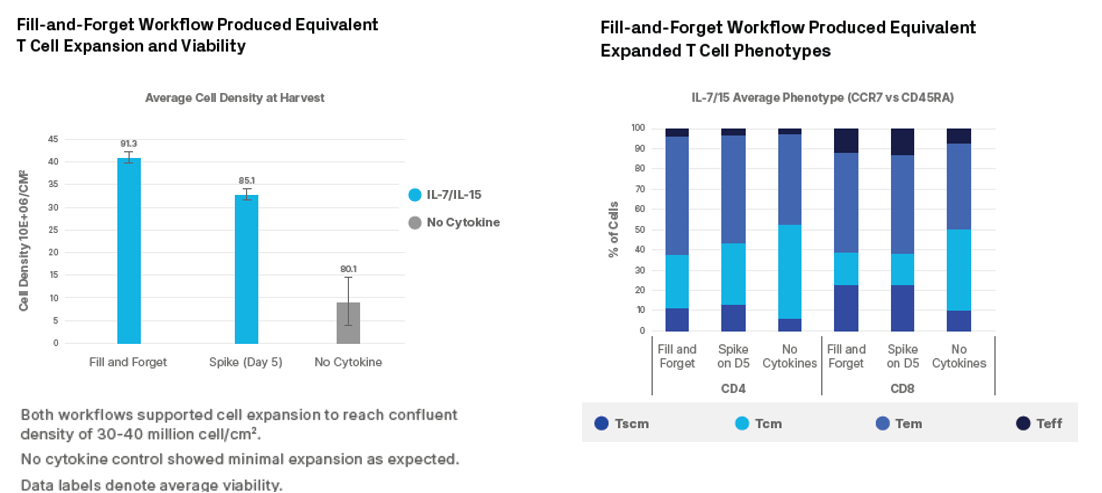
Is it better to add the media in a stepwise or fed-batch manner?
Frontloading a bolus of media at the onset of expansion, and maximizing the size of the cells’ nutrient pool and waste sink, has been demonstrated to yield better expansion kinetics.
Moreover, this approach directly reduces labor, risk, and variability associated with unnecessary operator interventions.
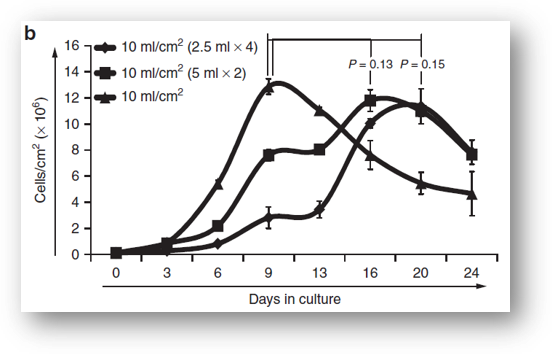
Bajgain P, Mucharla R, Wilson J, et al. Optimizing the production of suspension cells using the G-Rex “M” series. Mol Ther Methods Clin Dev. 2014;1:14015. Published 2014 May 14. doi:10.1038/mtm.2014.15
